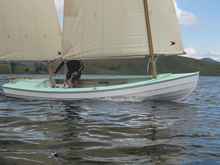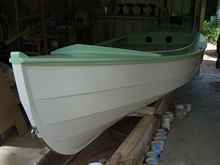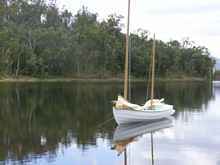Five people were sitting in a collection of old
easy-chairs on a wide verandah. Although it was mid-evening, it
had been a long hot day and the combination of an excellent meal
and some good wine had made everybody feel as though the time
was late. Beyond the verandah, enormous Blue Gums towered above
the surrounding trees and they swayed gently across the moonlit
Queensland sky. Possums ran through the underbrush in search of
food, wallabies nibbled the sweet grass and, just a short distance
away, a koala called for his mate.
 |
The friends were engaged in a conversation
about their favourite subject - classic small craft made
from wood.
Periwinkle launching day.
|
The friends were engaged in a conversation about their favourite
subject - classic small craft made from wood. But instead of the
normal never-ending arguments about which boat to build, what
building method to employ or which trip to plan next, the friends
were in a philosophical mood and the subjects were more serious.
“What concerns me,” said Mike Rowe, “is that
there are so many boats being built which look as though they
are trying to be something they aren’t”.
“Meaning what?” replied Paul.
Mike continued, “Well, you just go along to any classic
boat regatta and you’ll see lots of varnish, lots of laminated
components with contrasting colours, hulls made to look like something
from the nineteenth century, rigs with baggywrinkle, belaying
pins, wooden blocks and deadeyes. And of course, there will always
be lots of bowsprits, even though the rigs aren’t suited
to them.”
 |
“But why shouldn’t people have
those things if it makes them feel good,” said Ian,
“Just because your taste is different doesn’t
mean that you are always correct.”
Periwinkle Build |
“But why shouldn’t people have those things if it
makes them feel good,” said Ian, “Just because your
taste is different doesn’t mean that you are always correct.”
Then he continued, “Your old boat looks old-fashioned to
most people’s eyes, so you are just arguing about degree
– I say pull your head in and let everybody do their own
thing.”
“No, you are wrong,” said Mike, adding “as
usual”, under his breath. “The difference is that
some boats look like something from an earlier time because their
function or construction dictates it – not because they
have been made up to have a particular appearance for the sake
of it.” “What it comes down to is having an understanding
about why a particular hull-shape or rig came into being –
most boats followed lines of evolution because of the materials
the builders had, or the fastenings they could afford, or the
type of shore they launched and retrieved from, the cargoes they
had to carry, whether the boats were built professionally or by
the fishermen during the winter months – the list goes on
and on!” “But to build something to look a particular
way is just putting the chicken before the egg – form should
follow function.”
 |
“But to build something to look a particular
way is just putting the chicken before the egg – form
should follow function.”
Periwinkle under sail. |
Some could see that Mike was getting agitated and wasn’t
far from climbing onto his soapbox again. Paul tried to even things
out a bit by saying, “Yes, but you have to admit that my
boat looks traditional and old fashioned to most eyes and you
designed her!” “Don’t get me wrong – I
like her looks – but she has a clinker hull, an old fashioned
sprit rig, rope fittings and a sheer like a banana.”
“That is just my point,” replied Mike, sitting forward
in his chair and taking another pull at his drink, “Everything
about the look of that boat came about because of the materials
used, the construction method employed, the requirements of the
rig and the job she was expected to do – absolutely nothing
was an add-on for the sake of decoration.” Leaning back,
he continued, “That is the way it should be – the
shape of a boat should be determined by function alone.”
Ian couldn’t help himself, “If that is the case,
Mr. Know-it-all, why didn’t you design her with forward-raked
transom, a high-aspect ratio daggerboard and an asymmetrical spinnaker?”
“Because,” lectured Mike, “It would have taken
from one part of her function, which is that of a cruising dinghy.”
“She needed a particular shape of centreboard to allow for
proper placement of the rowing thwart; the rig had to be low and
easily stowed, with no stays; the wide planks dictated the shape
of the bow; and, a spinnaker would have got in the way when cruising.”
(Mike steered clear of the question of the transom rake, because
he knew it was done for looks and that the boat would have sailed
better with a vertical or even a forward-raked transom, but he
wasn’t going to give Ian any ammunition in this discussion.).
“Alright,” smiled Ian, “But what about the
transom – wouldn’t it have been more efficient if
raked forward?”
“Damn,” thought Mike to himself, but he was saved
by John’s comment.
“I think you’ll find Mike shaped that transom so
that it would allow for easy mounting of an outboard,” said
John, “He has done the same thing on my boat and it works
fine.” Continuing, John said, “I know what he means
about too much decoration on many boats – I believe that
the beauty of a boat should come from the shape of the boat –
her lines – not from lots of stripes and varnish. In fact,
that sort of thing almost acts like a camouflage. On many boats
there are so many colours and bits of decoration, that your eye
can’t see the shape of the hull as a whole. No, I agree
with Mike – keep to the minimum number of colours –
if the boat is beautiful, she won’t need decoration to look
good!”
 |
No, I agree with Mike – keep to the
minimum number of colours – if the boat is beautiful,
she won’t need decoration to look good!”
Periwinkle at anchor. |
“I agree,” interjected Mike, “Just think about
my good friend Doug. He has never bothered with varnish and his
boats are rather roughly painted – usually with a maximum
of two colours – but Doug’s boats look fine. He knows
what is really important and functional.”
As the night wore on, the friends moved onto other lines of conversation,
but Mike’s wife Ginny reflected quietly on the earlier discussion.
She had more experience aboard boats than any of the men and she
knew the value of simplicity and practicality. Ginny had heard
these men carry on in this way dozens of times and she was pleased
to know that they all valued her opinion. But, on this night,
she preferred to sit back and let them carry on with the various
topics of conversation, aware that the topics being discussed
– real and imaginary – were very important to the
group and that the business of building and using small wooden
craft would bring long-term contentment and happiness to them
all. She wondered to herself, why so many people were making boats
which were too complicated, expensive and difficult to maintain,
when all they had to do was keep it simple.
*******
Ross Lillistone, Wooden Boat Design, has a new boat under development
named Periwinkle. She is a 17 ft x 5 ft Cat-Ketch (periauger)
rigged Beachcruiser which carries 155 sq.ft. of sail in two balanced
lugsails.
The photos were taken on Wivenhoe Dam near Esk, Queensland, Australia.
It has an area of 109.4sq kms, a maximum depeth of 67m, has a
shore length of 462kms and holds 1 160 000 ml, which is 2.5 times
the volume of Sydney Harbour.

***** |

